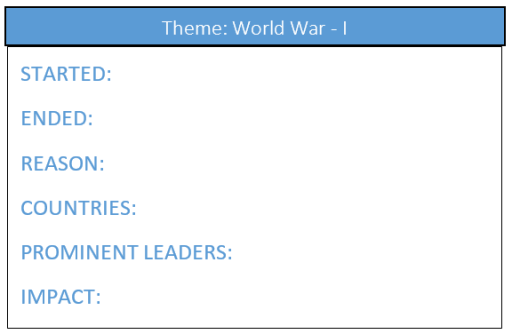Do Students Look up to Your Assignments?
Posted: April 27, 2016 Filed under: Teacher's Desk | Tags: assignment help, homework, Personalized Teaching, School Life, teacher Training, teaching methods 1 CommentAssignments are usually dreaded by students, be it at the primary school level or during postgraduation. Few teachers manage to make their assignments interesting enough for students. Such a trend has made plagiarism rampant in many submissions. It is also not uncommon for children to seek the help of older members in their family to submit the assignment on time.
The top complaint from most children is that assignments are akin to copying texts from reference books. Most students wish for assignments that are not time-consuming and do not require lots of expertise. They also fervently wish that assignments ultimately ‘mean’ something and are not just given for the heck of it. Perhaps it is time for us teachers who have trouble with late or incomplete assignments submissions to have our assignments relooked at.
Here’s a checklist to find out if the quality of assignments given is good, bad or otherwise:
Is the assignment personalized?
Children love to give a personal touch to assignments. Hence, assignments that ask for their point of view on topics, or assignments that ask them to write a poem or story tend to arouse interest in the students. The assignments that require students to conduct home experiments are considered some of the best, as these have a personalized touch and incite learning by doing.
Are the assignments the same for all students?
Students are smart. Often, they are smarter than the teachers expect. Common assignments are thus easily copied by everyone in the class, without any regrets. Such a habit must not be encouraged through assignments that are given en masse. Students should be given different topics as assignments. This may even prompt a discussion among them, on the given topics.
Do students learn from each other during assignments?
Two minds are better than one. Therefore, when more than one student works on a given problem statement, the solutions are noticeably better. Teachers must hence try to involve as many students as possible in the projects assigned to the class. Examples are science projects, plays, etc., which require a group effort. If this is not possible, teachers can also give marks to groups, according to the aggregate marks secured by the members of the group. This will encourage students to peer review their assignments and projects, something that’s very effective in the learning process.
Are assignments time consuming?
Assignments should not come in the way of daily studies and daily play. They should be a healthy part of the day, and should typically be around a half hour to one hour long. Beyond that, the tired minds of students will not work at their optimum capacity. But that’s not to be the case for secondary classes, where assignments are week-long. In such cases, time management is up to the children themselves. But even then, students must not be burdened, lest they grow a dislike to the subject itself!
Are they meant for students or experts?
Science experiments and projects are the usual suspects for an involvement of outside hands in the students’ assignments. This is simply because the expectations of the teachers from these projects are too high. Gone are the days when a student could bring lenses to class to explain phenomena of light, now the student has to come equipped with a PowerPoint presentation, a huge chart with explanations, and thankfully the lenses too. Such work requires expertise, which is expected of graduate students, not primary or secondary class goers.
To sum it up, assignments should be in the interest of students. They should not overburden them, and neither should they pressurize the children to stretch beyond their capacity. Also, assignments should be made more fun, so that the children respond to the demands of the class in a way that is encouraging to the teacher as well as fun for the children! Assignments are not meant to be dreary. They are a way to take back the fun and warmth of classrooms to home, in keeping with the fact that education is a never ending process.
One-to-Few: The Right Way Forward
Posted: March 14, 2016 Filed under: Teacher's Desk | Tags: Group tuitions, one-to-one tuitions, Personalized Teaching, teaching methods, Teaching Techniques, teaching tips Leave a comment“I need a teacher to provide personal attention to my child to ensure he learns well”
“My child needs to learn the following and I see that he is struggling a bit to do the same – Need your help on this”
We are sure while you read the above sentences, you were visualizing images of different parents who spoke the same words to you.
Now the real question is:
What does the student (or) a parent want from a teacher? Is it just personal attention to facilitate student learning?
(or)
Is it an achievement of the student’s learning outcome in an enjoyable learning environment? In simple words ‘Is the student learning and enjoying the way he/she learned things?’
I am sure there is no guidance required for anyone in picking the correct one from the above two questions.
It has been several years since the concept of ‘Individual Tutoring’ and ‘Group Tutoring’ gained popularity as extension avenues to everyday learning from the schools. But to us at vedantu, the questions are-
- Can One-on-One sessions provide an environment where students can collaborate?
- Can a group tuition ensure sufficient interaction time and attention span of the teacher with all students?
The solutions to these question lie in the fact that a great blend of offerings could enable a teacher handle both the above challenges effectively and make learning fun for the students.
One-to-Few – An offering where teacher handles just 3 to 7 students.
A blended model of teaching where the learning is personalized and gives enough room for each student to learn from his/her peers.
This calls for a detailed analysis of what this can do to the students and the teacher:
- Bonding within students and between the teacher and students is very strong
- This opens up room for the teacher to apply varied pedagogy
- Students have the opportunity to support and learn from each other
- Avenues for student interaction are more.
- Opportunity to provide personalized feedback still remains intact for the teacher
- Peer teaching and learning can be encouraged
- Teacher has the option to conduct group-based learning activities
- Content sharing/assessment evaluation happens in a controlled environment
Just awesome…Isn’t it? The new offering seamlessly handles a lot of learning and teaching challenges and yet offers interaction and blooming opportunities for students.
What do you think, don’t we see ANY challenges at all with this new offering to impart learning?
An honest answer would be – Yes, we do see some of them. The most common ones coming from teachers would be –
“As a teacher, I have varying levels of learners in the same batch”.
“I do not have enough time to interact with all students”
Though it seems that we should agree to the above challenges that teachers face, but with time and experience, we have understood that these challenges are only exclusive to unprepared teachers.
Now that we know the lacunae, let’s see how effectively we can handle them and explore a few ways to make the sessions awesome for both – the teacher and students
Do the Homework Right
Have a plan ready for each level of learner in your batch. Remember, these plans should ideally be the strategies that can be applied to learners in all your batches. These strategies can be broadly devised for three phases of your sessions- Pre-Session, In-Session & Post-Session. (These examples are just a few among the hundreds. It is just a question of exploring them)
For example, you can get to know the level of learners well before your session by asking them to fill a KWL chart

You can also get a hang of the student’s understanding of the concept taught by an Exit Ticket

You can additionally check the understanding of the entire group and individual students by asking them to create Concept cards/Theme Cards on the taught concept. The best part of this exercise is, students are allowed to create the listed parameters to cover the concept on their own, which they cannot do without going through the understanding of the concept and these tools can be used in all subjects as well.

Involve Multiple Intelligences
When a student can learn in different ways…Why teach them in one way?
Every student is different and unique are their learning abilities and adaptation to teaching styles. Some students grasp the concept well, just by verbal communication to them. Others understand well through images –Images & drawings. Whereas some are comfortable learning by doing various activities. Others may understand a concept well by practicing several worksheets. Also, it is a proven fact that students learn quickly and retain most concepts taught to them using multimedia.
Once a teacher makes sure that his/her session involves a blend of teaching tools and methodologies, catering to the aforesaid needs, the question of teaching effectiveness doesn’t even arises. The teaching is bound to be effective even for a set of students with varied learning levels.
Encourage Peer Learning through Collaborative Activities
It is a proven fact that students feel more comfortable to ask questions and express their lack of understanding on any concept with their peers. In a confined group with the same learning objectives, it is very easy to make students teach their fellow mates and learn from them as well. Remember, every student feels proud when given an opportunity to impart learning to his/her peers. They express well, collaborate and arrive at lateral outputs when given a chance to work as a team.
Customize Assessment Strategies
Work out a plan to customize your assignments and tests for students with the different pace of learning. Give a comprehension-level assignment for a slow learner, which would boost his/her confidence in learning the concept. Once the comprehension-level assignment is completed, the slow learner gains the confidence to go for the next level assignment and the teacher should encourage and ensure he/she completes the same as well.
Similarly, an application/synthesis-level assignment for a quick learner gives him/her opportunity to express the subject expertise and boosts creativity helping them move to the next level
Create Avenues for offline interaction
A WhatsApp group can do wonders to facilitate offline interaction between you and the students, as well as amongst the students of the batch. You can safely utilize the platform to introduce the peers, check their learning progress, and solve doubts or any other difficulties.
We are sure with slight modifications in your teaching style, your students can achieve oodles of confidence in the subject/topic taught and would add multi-fold to your teaching effectiveness.
Content and Pedagogy are directly proportional to the effectiveness if any One-to-Few session. It is your preparation, the plan and the genuine willingness to execute that creates all the difference.
Trust Us… at the End of the day… It is truly worth it…
This article is contributed by Dr. Sundar Rabindranathan
He is an educational consultant and trainer who has trained students & teachers in more than 300 schools throughout India. Sundar currently heads Teacher Management at Vedantu and likes to play badminton in his free time.



